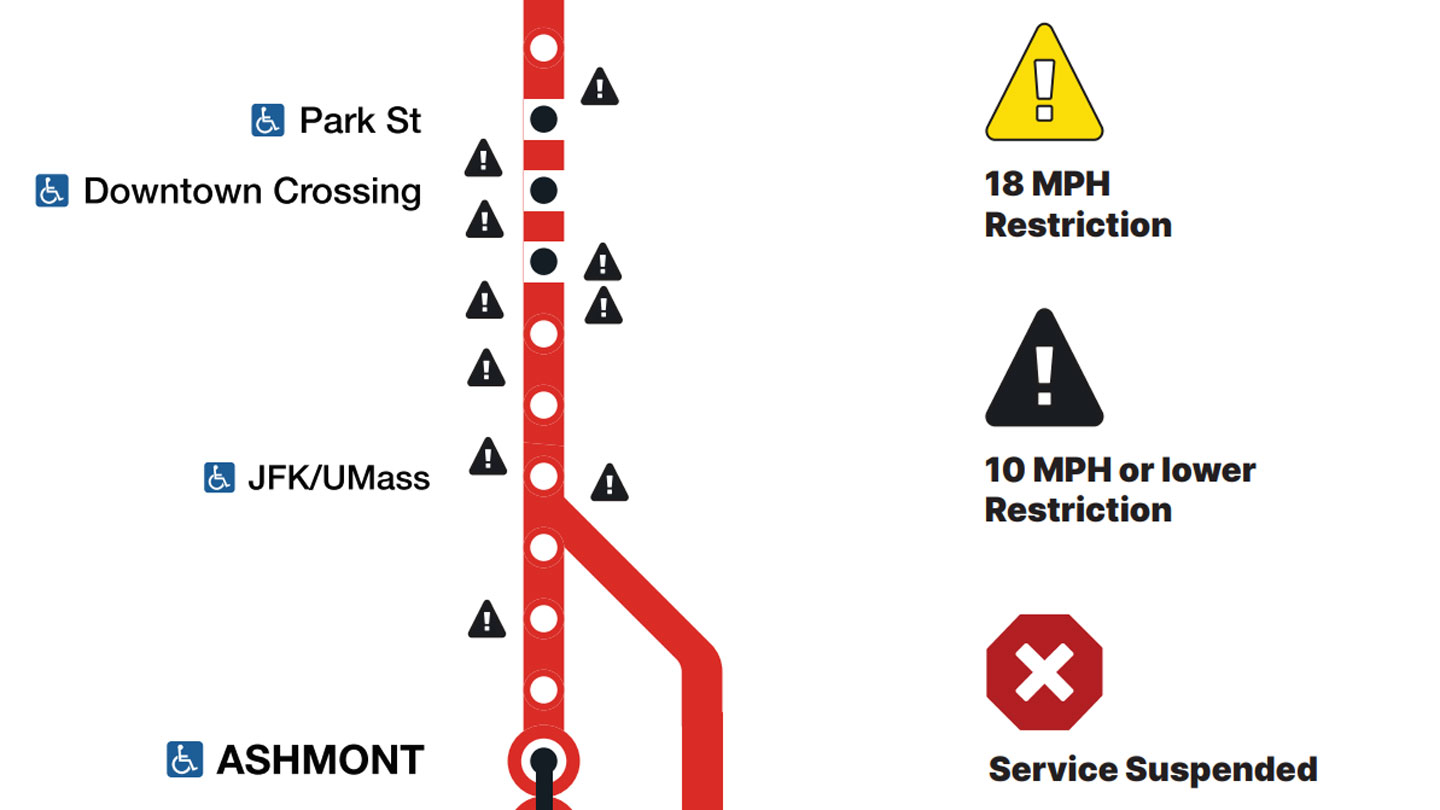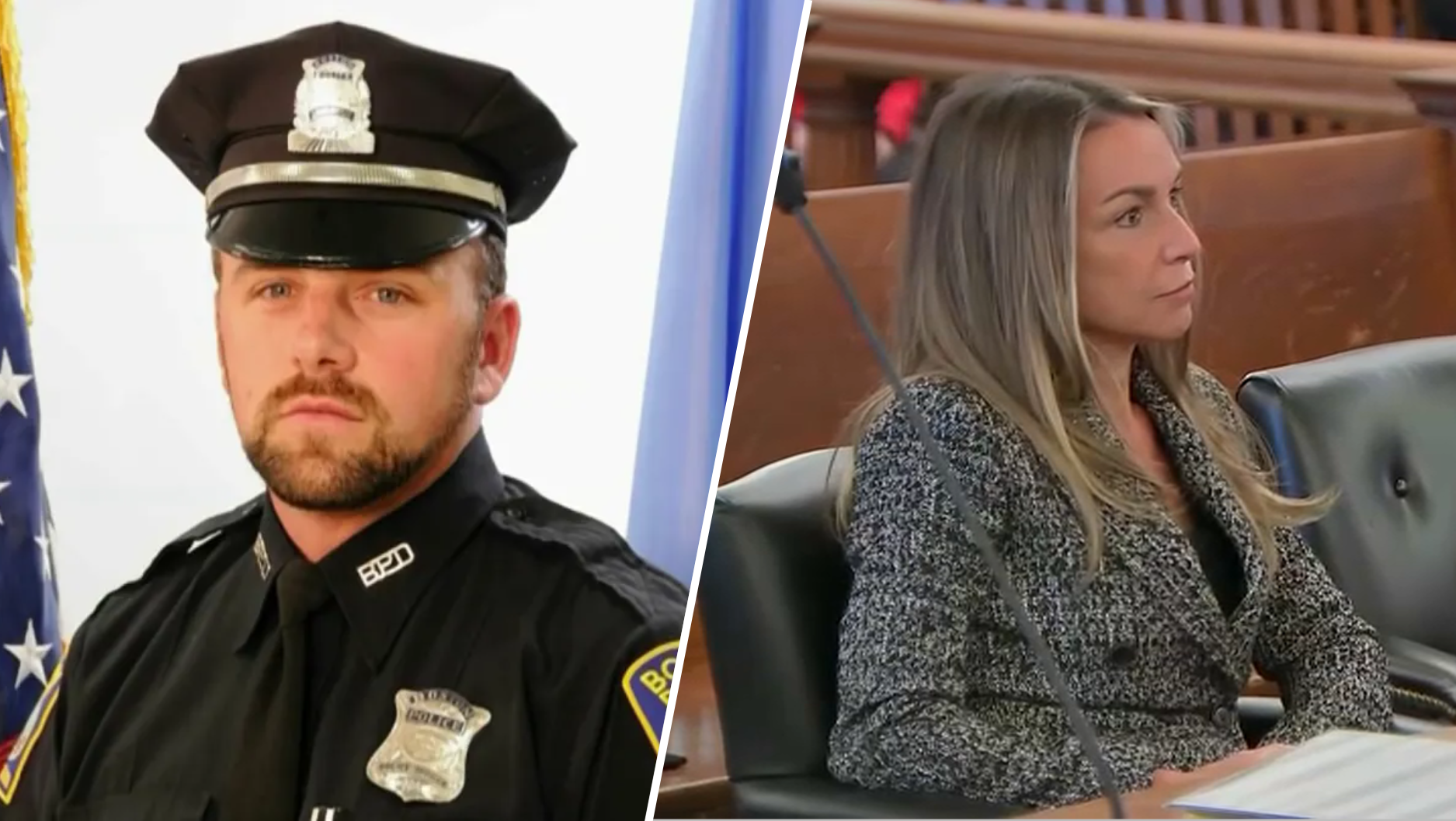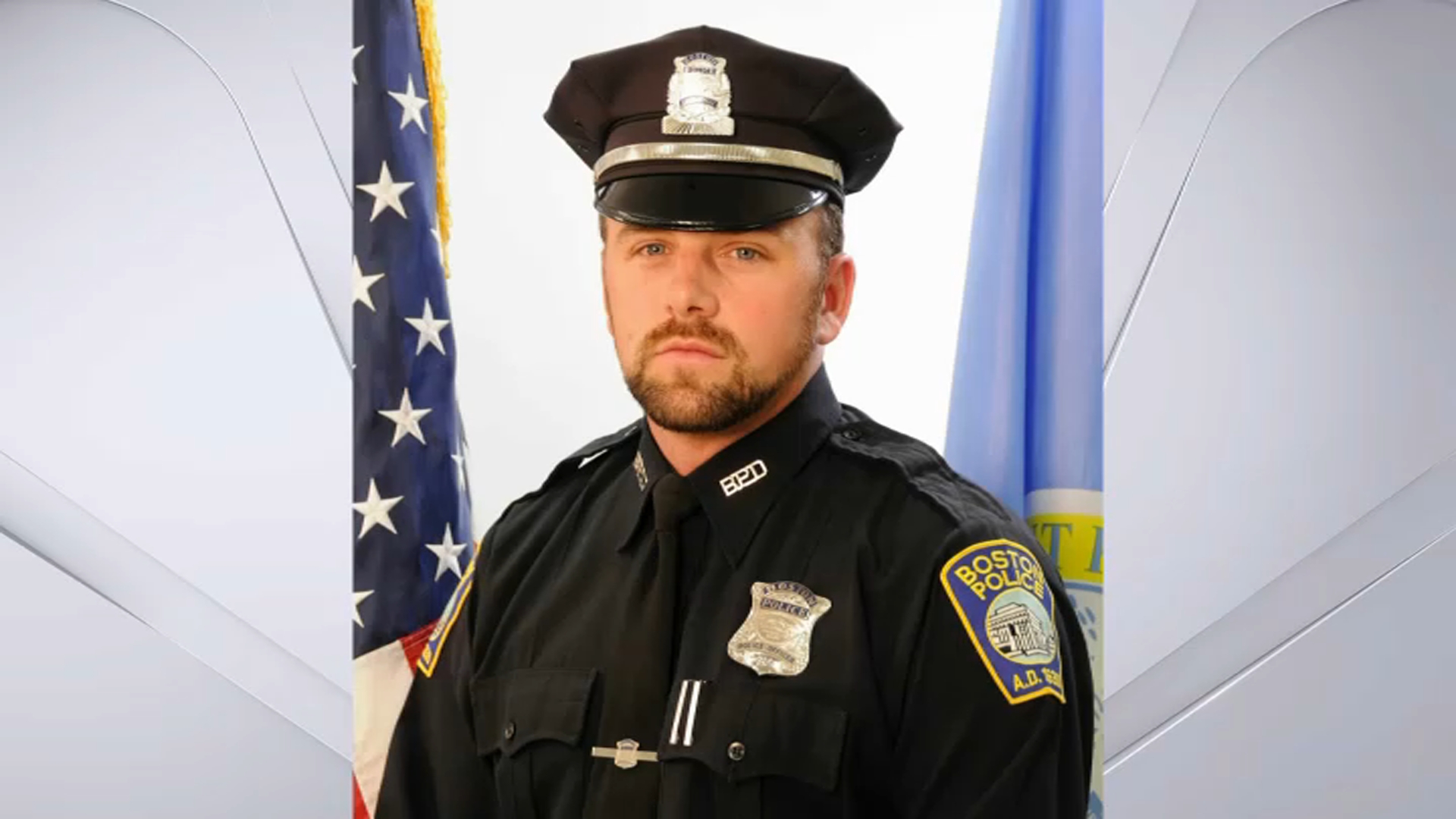A Massachusetts woman is charged with embezzling over $650,000 from a Brookline medical practice and using the funds to pay off her personal purchases at Louis Vuitton, Bloomingdales, Best Buy, Target and travel-related websites, according to the U.S….
Massachusetts
One T subway line now has no slow zones
There are now no slow zones on the entire length of the MBTA Blue Line, the transit agency announced Wednesday.
It’s the only T line with no speed restrictions, according to the MBTA’s slow zone dashboard.
Two weeks ago, there were 16 restrictions on the Blue Line, limiting trains’ speed on 38% of the line. But the agency closed down one stretch of the line for track work over a few weeks and used a full shutdown this weekend to finish it up.
The T says the work has sped up travel on the Blue Line by three minutes.
MBTA General Manager Phillip Eng and MBTA Chief Operating Officer Ryan Coholan were set to hold a news conference Wednesday afternoon to discuss the update.
There are 95 speed restrictions across the rest of the T as of Wednesday: 54 on the Red Line (18% of the track), 31 on the Orange Line (17% of the track) and 10 on the Green Line (2% of the track). The MBTA says that it’s the first time in over a year that there are fewer than 100 speed restrictions across the system.
Slow zones are put in place for sections of track where it’s not considered safe to run trains at full speed because of wear and tear on the track. The MBTA has targeted those areas for repairs.
Eng has released a plan aimed at removing all MBTA slow zones by the end of the year.
More on MBTA slow zones
This story uses functionality that may not work in our app. Click here to open the story in your web browser.
Art Institute debt relief affects 3,500 in Mass.
The Biden administration approved over $80 million in debt relief on Wednesday to more than 3,500 Massachusetts borrowers who attended the Art Institutes, including the New England Institute of Art in Brookline.
The federal debt relief for Bay Staters is part of a $6.1 billion student loan relief package to 317,000 borrowers who attended Art Institute campuses around the country.
U.S. Education Secretary Miguel Cardona said the relief is targeted to borrowers who were “cheated by their college.”
“Schools that use flashy marketing materials and high-pressure recruiting tactics to sell higher education is equivalent to snake oil,” he said on a press call. “Art Institute engaged in widespread and sustained practices that misled borrowers about the value of their degree, their ability to find jobs.”
Cardona said Art Institute advertised that over 80% of graduates got jobs in their field, though they “knew that wasn’t true.”
“They also lied about the salaries that graduates earned. School staff admitted to making up salary information,” he said. “They used the earnings of celebrities whose millions had nothing to do with Art Institute to their averages, including the income of tennis great Serena Williams.”
Students and parents of students who enrolled in Art Institutes on or after Jan. 1, 2004 through Oct. 16, 2017 are eligible for debt relief.
The announcement follows a 2018 lawsuit filed by Massachusetts’ attorney general’s office, which alleged, among other things, that New England Institute of Art and owner Education Management Corporation violated the Massachusetts Consumer Protection Act by misrepresenting the likelihood of job placement to prospective students in order to induce enrollment.
In 2019, Suffolk Superior Court entered final judgment against NEIA and EDMC, ordering them to pay restitution of approximately $60 million plus interest based on the amount of tuition paid by NEIA students. They were also ordered to pay $11,765,000 in penalties. EDMC and NEIA filed for bankruptcy in 2018.
The relief represents one of the largest group discharges of student loans across the country to date, adding to the nearly $29 billion in debt relief the Biden administration has granted so far over the last three years.
“In Massachusetts alone, 930,000 borrowers owe nearly $32.5 billion in federal student loan debt; approximately 40 percent of these borrowers are 35 or older,” Attorney General Andrea Campbell said. “Even more alarming is the fact that many borrowers owe more today than they did when they originally borrowed, for instance of borrowers who first entered college in the 2003-2004 academic year, more than one third had a higher balance in 2015 than what they did when they originally borrowed.”
The group discharge will provide debt relief automatically to borrowers starting Wednesday. Borrowers do not need to take any action.
Historic sites in Concord are among most endangered in US, preservation group says
Minute Man National Historical Park, Walden Pond and other historic places near Concord, Massachusetts, are threatened by the planned expansion of a private airfield, according to a major preservation group.
The National Trust for Historic Preserva…
Takeaways from the first 2 days of testimony in the Karen Read murder trial
Court is not in session Wednesday, meaning there will be no testimony in the high-profile Karen Read murder trial. Testimony is scheduled to resume on Thursday at 9 a.m.
Read is charged with second-degree murder in the 2022 death of her boyfriend, Boston Police Officer John O’Keefe. He was found in the snow outside fellow Boston Police Officer Brian Albert’s home in Canton, Massachusetts. Prosecutors say Read hit O’Keefe with her SUV, while Read says she has been framed in a wide-ranging coverup. Read has pleaded not guilty and is free on bond.
Through the first two days of testimony, jurors have heard from family members of O’Keefe, along with police officers and firefighters who responded to the scene of his death in Canton, Massachusetts, in January of 2022.
Legal experts have told NBC10 Boston that some of that early police testimony has shown that the investigation into O’Keefe’s death “wasn’t thorough.” Read’s defense team has already poked holes in police protocols, questioning why investigators didn’t go into the home or talk to the homeowner’s after O’Keefe was found.
“As a law enforcement investigator, the first thing you’re looking for are facts. Facts lead to evidence, evidence can be gleaned from eyewitness accounts, from the Ring doorbells, anything that can help you stitch this mystery back together again,” security analyst Todd McGee, a retired Massachusetts State Police trooper, told NBC10 Boston. “And the fact that the investigation wasn’t thorough provides a big wrinkle in the prosecution’s case.”
Here’s what we’ve learned through two days of testimony in the controversial murder case:
Day 1: Opening statements, O’Keefe’s brother, sister-in-law testify
The trial opened Monday with prosecutors saying a cracked taillight and Read’s own words to firefighters that she “hit him” will prove she is guilty.
“The defendant, Karen Read, is guilty of murder in the second degree, striking the victim, Mr. O’Keefe, with her car, knocking him back onto the ground, striking his head on the ground, causing the bleeding in his brain and swelling, and then leaving him there for several hours in a blizzard,” Assistant District Attorney Adam Lally told the jury.
As the case unfolded, the defense’s strategy has been to portray a vast conspiracy involving a police coverup. It has earned Read a loyal band of supporters — who often can be found camped out at the courthouse — and has garnered the case national attention.
“Karen Read was framed,” Read’s defense attorney David Yannetti told the jury. “Her car never struck John O’Keefe. She did not cause his death and that means somebody else did.”
The couple had been to two bars on a night in January 2022, prosecutors alleged, and were then headed to a party in nearby Canton. Read said she did not feel well and decided not to attend. Once at the home, O’Keefe got out of Read’s vehicle, and while she made a three-point turn, she allegedly struck him and then drove away, prosecutors said.
Prosecutors haven’t said where they think she went after that. However, they allege she later became frantic after she said she couldn’t reach O’Keefe. She returned to the site of the party, where she and two friends found O’Keefe covered in snow. While on the scene, firefighters said she told them “I hit him, I hit him, I hit him.”
He was pronounced dead at a hospital. An autopsy concluded he died from head trauma and hypothermia.
Investigators found a cracked right rear tail light near where O’Keefe was found and scratches on her SUV. Prosecutors are also expected to present evidence of injuries suffered by O’Keefe consistent with him being hit by the car and strains in the couple’s relationship including a “20 minute screaming match” witnessed by O’Keefe’s two adopted children they had while on vacation in Aruba.
The defense has spent months arguing in court that the case was marred by conflicts of interest and accused prosecutors of presenting false and deceptive evidence to the grand jury. In a motion to dismiss the case, the defense called the prosecution’s case “predicated entirely on flimsy speculation and presumption.” A Superior Court judge denied the request.
On Monday, Yannetti argued that close relationships between investigators and those in the house resulted in authorities focusing solely on Reid, whom the defense described as a “convenient outsider.”
Yannetti also claimed investigators failed to consider the possibility that O’Keefe got into a fight at the party and was left for dead outside. While not offering evidence of who was responsible, they laid out of a series of missteps in the investigation — failing to investigate a history of animosity between O’Keefe and the family who owned the home nor searching the home for evidence of a struggle.
They also are expected to provide evidence that Read’s taillight was damaged when she hit O’Keefe’s car hours later at their home — not at the party — and dispute that the couple had a strained relationship. They got along well that night and had made plans for several trips in the months ahead.
“You will question the Commonwealth’s theory of the case,” Yannetti said. “You will question the quality of the Commonwealth’s evidence. You will question the veracity of the Commonwealth’s witnesses and you will question their shoddy and biased investigation.”
In August, Norfolk District Attorney Michael Morrissey criticized suggestions that state and local enforcement were orchestrating a cover up, saying there is no evidence to support O’Keefe was in the Canton home where the party took place nor was in a fight.
The idea that multiple police departments and his office would be involved in a “vast conspiracy” in this case is “a desperate attempt to reassign guilt.”
Such comments have done little to silence Read’s supporters, dozens of whom dressed in pink for the first day of the trial.
The first witness in the trial was O’Keefe’s brother, Paul, who described in harrowing detail having to rush to the hospital that morning, walking past Read, who was repeatedly screaming “Is he alive?” and into a room where his brother’s body was covered partially with a white sheet.
“He was pretty banged up,” Paul O’Keefe told the jury, detailing how his brother had blood running down his mouth and nose and markings on his right arm. “What really stood out to me was the eyes. It was as if there were ping pong balls under his eyelids.”
The second witness to take the stand for the defense was Paul O’Keefe’s wife, Erin. She testified about the Aruba trip, saying that Read reached out to her to say that she had seen John O’Keefe kissing someone else in the lobby of the hotel they were staying at.
She also testified about speaking to Read by phone soon after the body was discovered: “She just yelled back in the phone, ‘John’s dead!’”
Day 2: First responders take the stand
Read’s demeanor and the words she uttered at the crime scene were the focus Tuesday on the second day of her trial.
Testimony from two police officers and two firefighters who arrived on the scene early Jan. 29, 2022, described a chaotic scene in which O’Keefe was laying face up and Read was attempting to give him CPR. She had blood on her mouth, possibly from giving him mouth-to-mouth resuscitation. They described Read as distraught and screaming and that O’Keefe had no pulse and wasn’t breathing.
They also described interactions with Read, in which she made statements that appear to implicate her in O’Keefe’s death.
Timothy Nuttall, a Canton firefighter who treated O’Keefe at the scene, recalled Read repeatedly saying, “I hit him,” when she was asked about what happened.
That built on testimony late Monday from Canton Police Officer Steven Saraf, who was among the first to arrive on the scene. He recalled Read being upset and saying: “This is my fault. This is my fault. I did this.” He also said Read repeatedly asked, “Is he dead?”
Defense attorneys on Tuesday attempted to discredit Saraf and raise doubts about the integrity of the investigation by pointing out mistakes made in the police dispatch log, including the wrong address where O’Keefe’s body was found. They also pointed out that Saraf never wrote in his police report that Read said, “This is my fault,” only that she screamed, “Is he dead?”
“In the two times you were asked to reflect back on exactly what happened on that morning Jan. 29 and Jan. 30, both times you attributed only three words to my client having been repeated continually in her distraught state, ‘Is he dead,’ right?” Read’s attorney Alan Jackson asked Saraf. In response, Saraf said yes.
But when Jackson tried to suggest Saraf’s memory of that morning was evolving, Saraf said that the discrepancy between what he initially wrote and what he later testified at the trial was “an oversight.”
The defense team also tried to raise doubts about what Nuttal heard, suggesting he was too focused on saving O’Keefe’s life to hear conversations around him. They also were able to get Saraf and another police officer to acknowledged they never heard Read say that she hit O’Keefe.
The defense also used the testimony from the police and firefighters to raise doubts more broadly about the investigation.
They were able to get Saraf and Canton Police Officer Stephen Mullaney to acknowledge they never saw pieces of broken taillight at the scene, which prosecutors say was found near O’Keefe’s body and are proof that Read backed her SUV into O’Keefe.
Initially, Nuttal said he couldn’t say whether the injuries — including a hematoma or egg over his right eye — came from a fight. But when pressed by Jackson, Nuttal acknowledged the injuries were consistent with getting beaten up.
The trial is expected to last six to eight weeks, with full days on Mondays, Wednesdays and Fridays, and half days on Tuesdays and Thursdays.
Light rain, calmer weather Wednesday, summer sizzle on the way
We’re on the back edge of cloudy-skies and rain, but the sea breeze means another day of cooler conditions in the 50s at the coast.
The afternoon will features sun, which helps areas across MetroWest and Middlesex County, touch the upper 50s …







